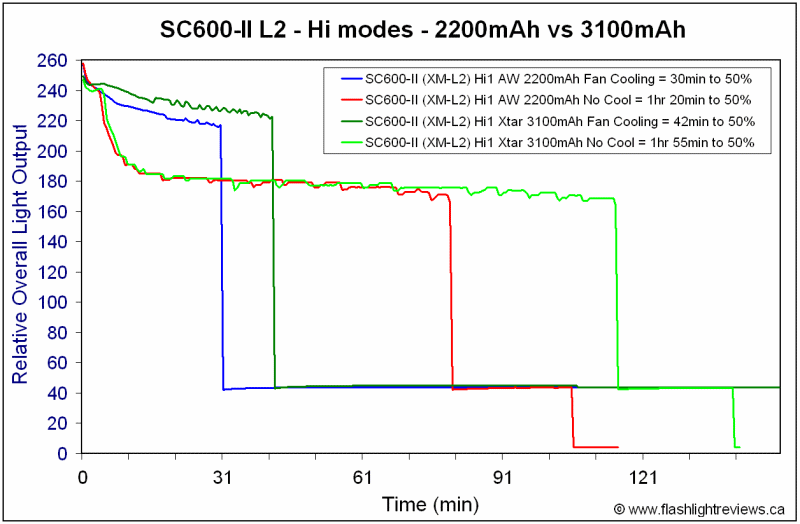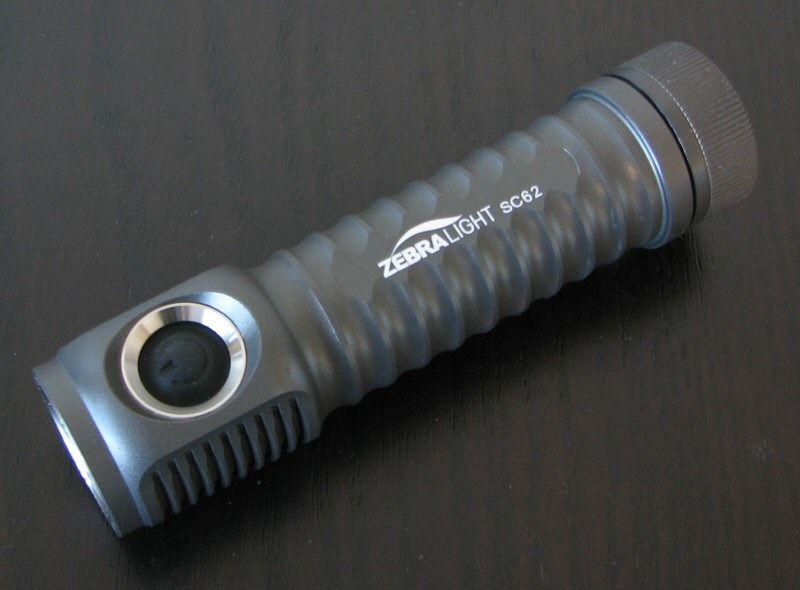
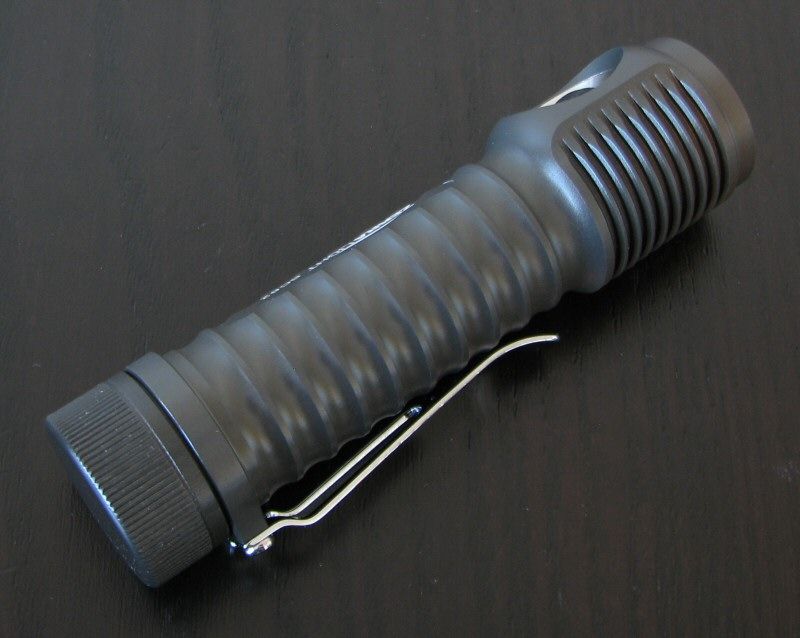
The SC62 is a new compact 1x18650 light from Zebralight (and uses the same circuit as the H600/H602 headlamp). In flashlight form, the SC62 looks like a slightly longer version of the 1xAA SC52 flashlight. It uses a similar PID thermal regulation system as the SC600-II that I have reviewed previously.
I expect performance will be close to the SC600-II, with a beam pattern similar to the SC52. Scroll down to find out exactly how it compares to other lights. :wave:
Manufacturer Reported Specifications:
(note: as always, these are simply what the manufacturer provides – scroll down to see my actual testing results).
- LED: Cree XM-L2 Cool White (Nominal CCT 6300K)
- User Selectable Levels: 3 main levels (High, Medium and Low). Each main level can be programmed to one of its two sub-levels. The second sub-level of the each main levels can be further programmed to different brightness levels.
- Light Output (runtimes): High: H1 1000 Lm (PID, approx 2 hr) or H2 620 Lm (PID, approx 2.5 hrs) / 350 Lm (3.9 hrs) / 160 Lm (11 hrs) - Medium: M1 70 Lm (30 hrs) or M2 32 Lm (66 hrs) / 12 Lm (172 hrs) - Low: L1 3.7 Lm (16 days) or L2 0.4 Lm (2.5 months) / 0.06 Lm (4.6 months) / 0.01 Lm (5.5 months) - Beacon Strobe Mode: 0.2Hz Beacon at Low / 0.2Hz Beacon at H1 / 4Hz Strobe at H1 / 19Hz Strobe at H1
- Light output are ANSI out the front (OTF) values. Runtimes tested (and parasitic drain estimated) using ZL634 batteries.
- Operating Voltage Range: 2.7V - 4.2V
- Battery: One 18650 size (up to 69mm long) 3.6/3.7V li-ion rechargeable. Batteries are not included in the package.
- Parasitic Drain: Negligible (much less than the self discharging of a battery)
- Beam Type: 80 degree spill, 12 degree hot spot
- Dimensions: Head Diameter: 0.96 inch (24.4 mm), Length: 3.8 inch (96.5 mm)
- Weight: 1.4 oz (40 gram)
- PID thermal regulated outputs (1000 and 620 Lm)
- Battery capacity indicator (LED flashes 1-4 times, 4 short clicks to start)
- Automatic stepping down from High to Medium, and from Medium to Low when battery capacity is low
- Built-in over-discharging protection (2.7V cutoff)
- Durable electronic soft-touch switch
- Smart user interface provides fast and easy access to all brightness levels and beacon-strobes.
- Precision machined unibody casing from premium grade aluminum bar stocks
- Proprietary heat sinking design bonds the LED board directly to the unibody aluminum casing
- Durable natural hard anodized finish (Type III Class I)
- Sealed and potted LED driver circuitry
- Battery reverse polarity protection
- Tempered optical grade glass
- Orange peel textured reflector
- Waterproof to IPX7 (2 meters, 30 minutes)
- MSRP: ~$85
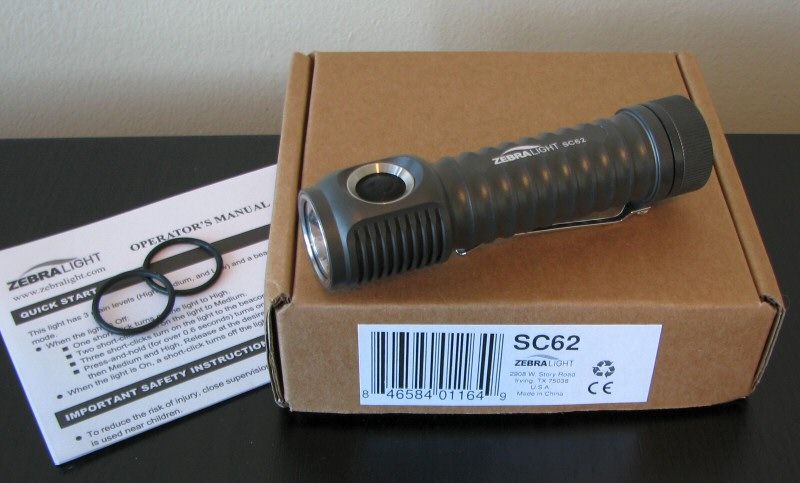
Inside the standard eco-friendly Zebralight cardboard box, you fill find the light with pocket clip, spare o-rings, and manual.
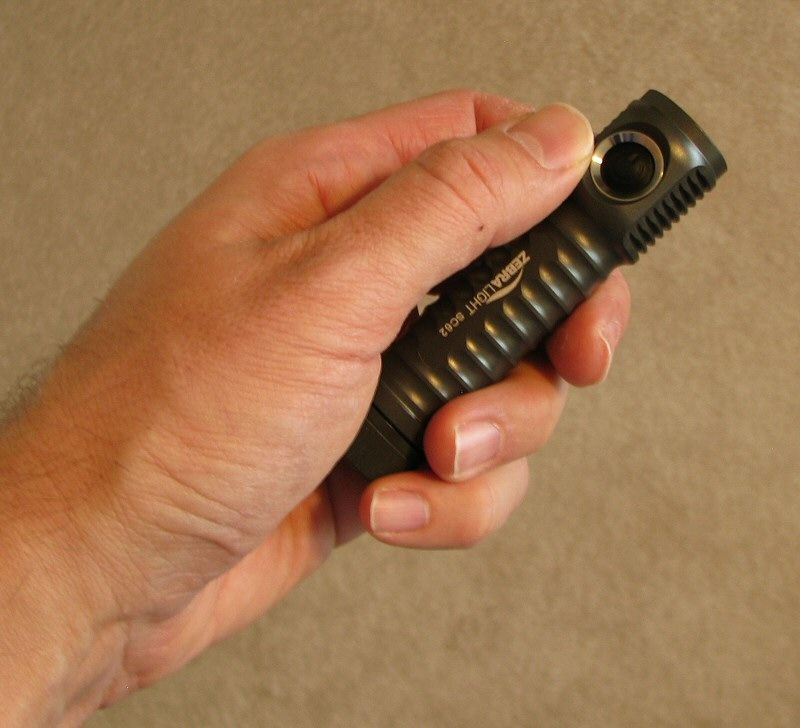
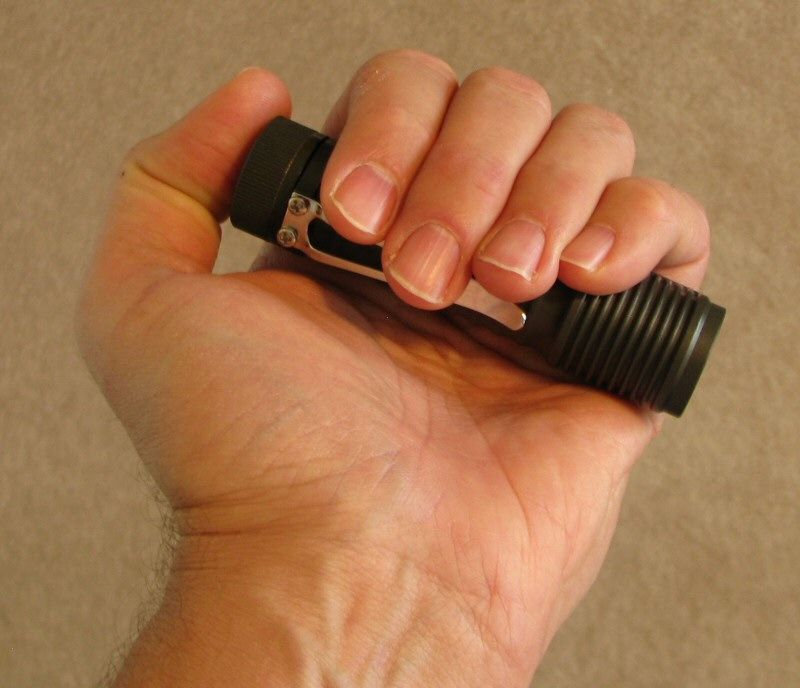
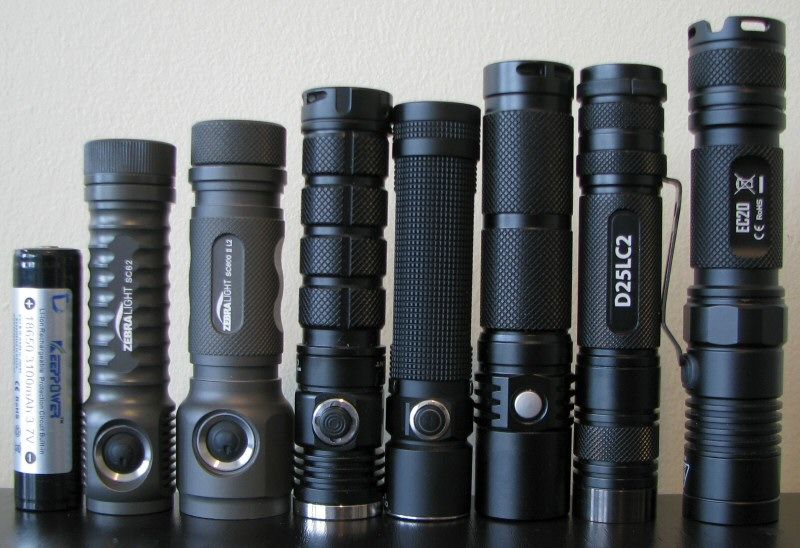
From left to right: Keeppower Protected 18650 3100mAh; Zebralight SC62, SC600-II, ; Skilhunt DS20; Olight S20-2013; Thrunite Neutron 2C 2014; Eagletac D25LC2; Nitecore EC20.
All dimensions directly measured, and given with no batteries installed:
Zebralight SC62: Weight: 42.3g, Length: 96.5mm, Width (bezel): 23.2mm, Width (max) 26.1mm
Zebralight SC52: Weight 39.5g, Length 79.0mm, Width (bezel): 22.6mm, Width (max) 25.4mm
Zebralight SC600 II: Weight 79.3g, Length: 101.8mm, Width (bezel) 29.7mm
Eagletac D25LC2: Weight: 50.0g, Length: 116.3mm, Width (bezel): 22.5mm
Eagletac TX25C2: Weight 93.6g, Length: 120.4mm, Width (bezel): 31.6mm
Fenix PD35: Weight: 82.7g, Length: 138.1mm, Width (bezel): 25.4mm
Nitecore EC20: Weight: 77.1g, Length: 129.2mm, Width (bezel): 25.4mm
Nitecore P10: Weight 82.0g, Length: 135.1mm, Width (bezel): 25.5mm
Nitecore P12: Weight: 89.7g, Length: 139.4mm, Width (bezel): 25.4mm
Olight S20 (2013, XM-L2): Weight: 52.4g, Length: 106.5mm, Width (bezel): 23.1mm
Skilhunt DS20: Weight: 53.8g, Length: 110.0mm, Width (bezel): 24.0mm
Sunwayman C20C: Weight 57.6g, Length: 104.8mm. Width (bezel): 25.6mm
Thrunite TN12-2014: Weight: 80.0g, Length: 140.5mm, Width (bezel): 25.4mm
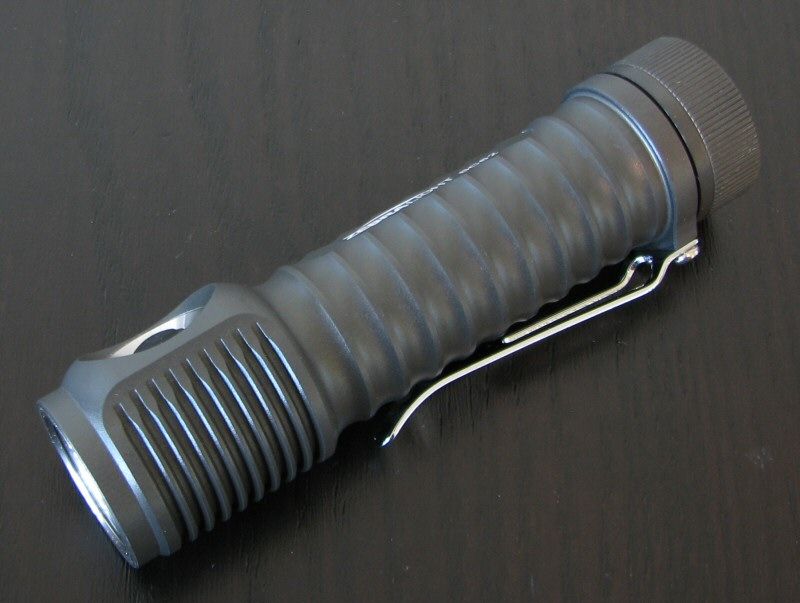
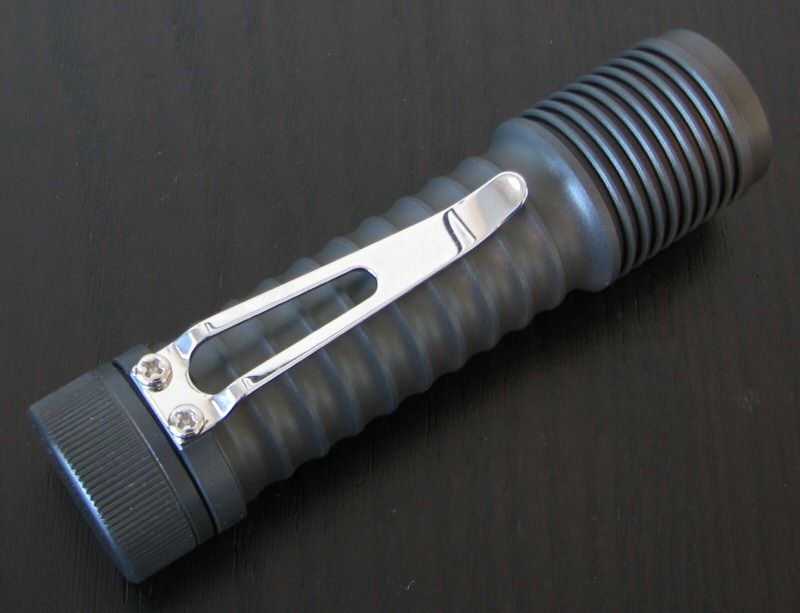
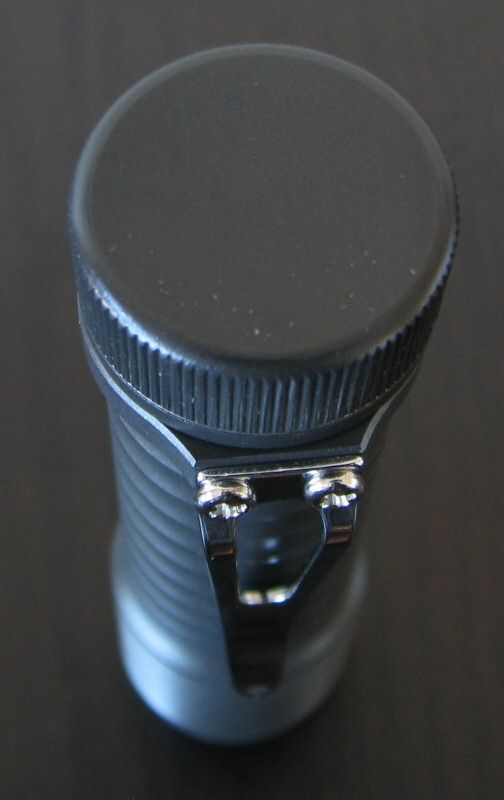
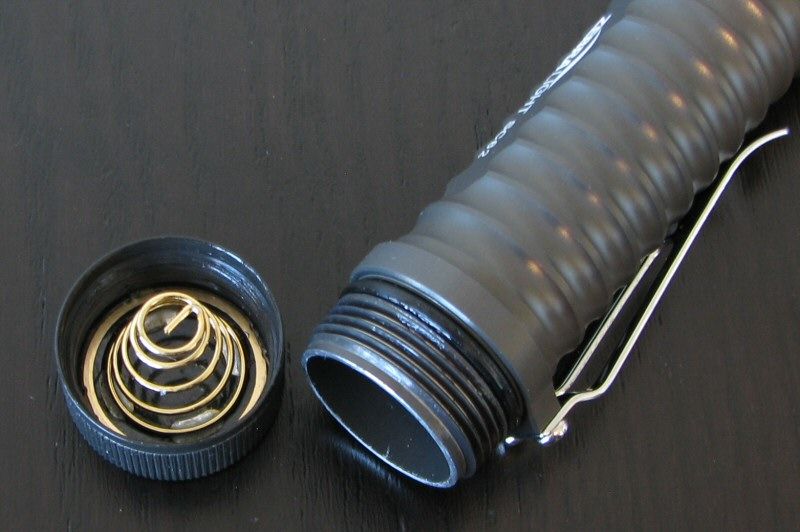
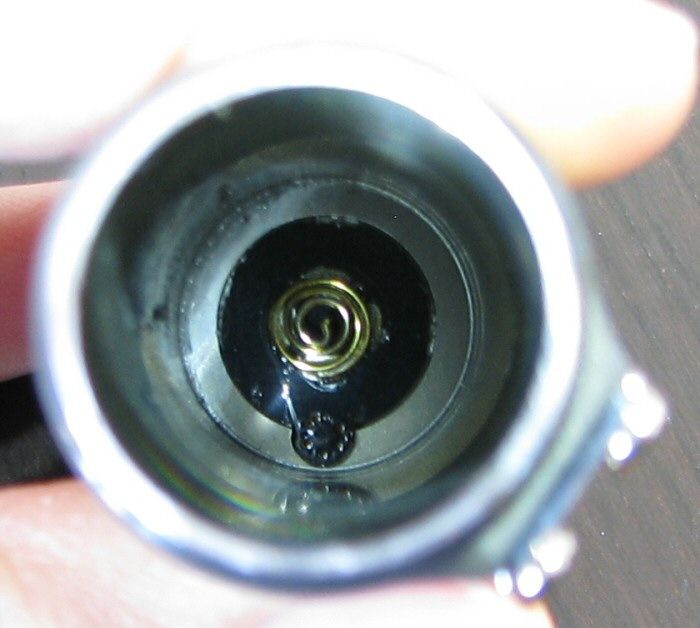
The overall build is very similar to the 1xAA SC52. The body is a little longer and wider to accommodate an 18650 cell of course, but the overall head seems identical. The most obvious changes from the SC600-II are the smaller head and new body-ridge design (internal body diameter is identical). The SC62 is certainly quite compact for the 18650 class.
Gone is the traditional knurling of the SC600-II. Instead, the SC62 shares a similar raised ridge design as the SC52. The fins in the head are even more pronounced on the SC62. Grip is good thanks to all the ridge detail on the body
Anodizing on my sample is the "dark gray" natural finish from Zebralight. I had found recently that a lot of Zebralights seem to have a lighter olive color. Personally, I'm glad to see this darker color back again – but realize that natural anodizing can be highly variable.
The SC62 comes with a removable metal pocket clip, held in place by two regular Phillips head screws. This looks to be the same as the SC52, and differs from the more easily removable clip of the SC600-II.
As with many other Zebralights, the SC62 has a small flat-bottomed tailcap, and an electronic control switch in their head. The electronic switch cover has a textured grip, and is well recessed (i.e., Zebralight has increasingly recessed the switch over the years, to reduce accidental activation). Switch feel is firm, with a definite "click" – very similar to my SC600-II (i.e., firmer than my original SC52).
Tailcap threads are anodized, allowing for tailcap lockout. :thumbsup: This is important on all lights with electronic switches, as accidental activation can be an issue. Threads seem of comparable size and thickness as the SC600-II (although the tailcap itself is slightly smaller, with a design similar to the SC52). The light can tailstand.
As with the SC600-II, there is a small spring on the positive terminal contact board in the head. All my 18650 cells seem to fit and work inside the light (although really long or thick protected high capacity batteries may have issues).
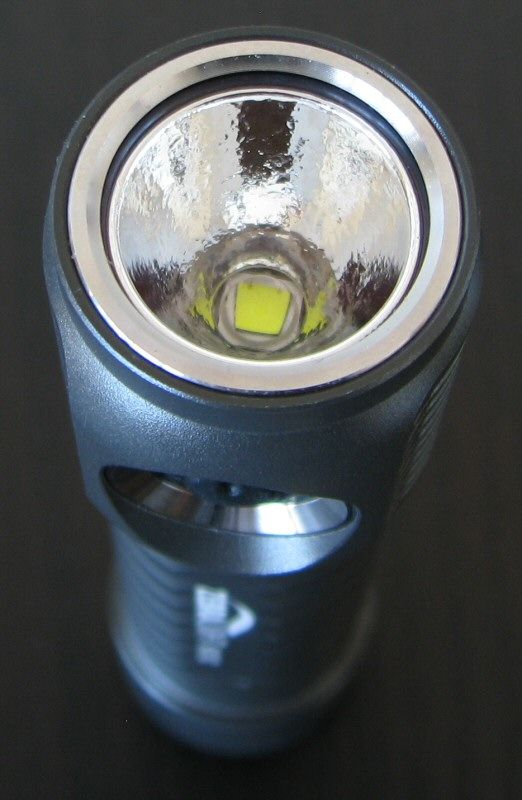
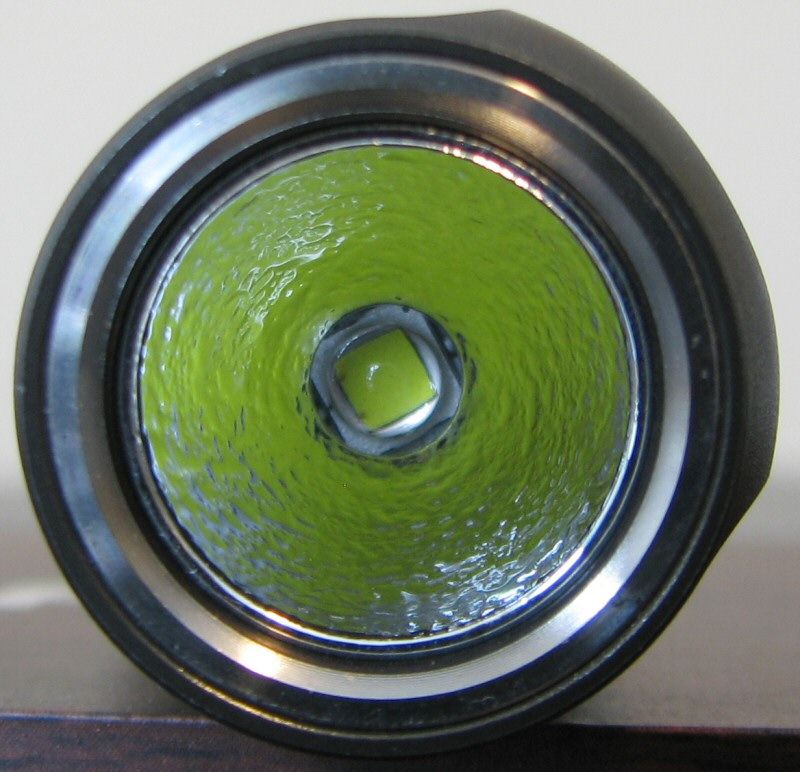
The head looks very much the same as the SC52. The light has a flat stainless steel bezel ring that appears to be press-fit into place. Reflector is lightly textured, and seems to be the same dimensions as the SC52. The cool white XM-L2 emitter was well centered on my sample (neutral white also available). I would expect a very similar beam pattern as the SC52, but with a max output closer to the SC600-II.
User Interface
The SC62 uses the latest variant of the Zebralight interface (i.e., very similar to my SC600-II). While it may sound a little complex when first described, it is actually quite easy to use.
As always, On/Off and all mode switching is controlled by the single electronic clicky switch. The main level choices are Lo – Med – Hi. There are two possible memorized outputs at each level, commonly referred to as 1 or 2 (e.g. L1/L2, M1/M2, H1/H2). And for each of the second levels, you can choose between 2 or 3 options. This gives you a total of 11 constant outputs to choose from. There are also 4 blinking modes.
I know that may sound confusing, but the interface is actually well laid out for simple operation. Let me walk you through everything:
Basic Operation
By default, the light is set to come on in a Hi, Med or Low mode. You could therefore easily use the light as a simple, straight-forward three-mode light, if you want.
To get Hi initially, do a quick single click from Off. A double-quick-click from Off gets you Med. A slightly longer press and hold from Off (i.e. >0.6 sec) turns on the light in the Lo mode.
At any time when On, simply press-and-hold to advance through Lo > Med > Hi, in a repeating loop. Release the switch to select the level. As before, a quick click turns off the light.
A triple-quick-click from Off gets you Beacon/Strobe mode.
As with everything on a Zebralight, it takes a bit of use to get the timings right. For example, if you click again too soon after a turning On, you may get an unexpected mode (i.e., need to wait a sec before trying to turn Off).
Secondary Modes
When On, a quick double-click at any time switches to/from the secondary mode for that level (referred to as 1 or 2 for each level). So for example, double-click to move from H1 to H2. The light will memorize your choice and return to it next time you cycle or turn on at this level. The memory even lasts through battery changes.
Advanced Operation
As with other Zebralights, you also have a few choices as to what the secondary mode can be for each level. In fact, there are 3 possible H2 levels and L2 levels, and 2 possible M2 levels (as before).
To enter the programming feature, double-click the light 6 times rapidly in any given level. Now, every additional double-click will advance you through the two/three programmable options for that level. To select the mode you want as the secondary level, simply turn off the light once you have made your choice. When you next turn it on, that last level will have been memorized (as H2, M2 or L2), and returned to automatically.
This same maneuver works for selecting the blinking modes as well (accessed as triple-click from Off). So, you switch between the four blinking options by double-clicking the switch once On in this state (a single click reverts you to the constant output modes). Mode sequence for the blinking modes is: Hi Beacon > Slow Strobe > Fast Strobe > Lo Beacon, in repeating sequence.
Battery Indicator
Another feature is a relative battery life remaining indicator. Quadrupule-click the switch from Off, and the main emitter flashes out a relative battery strength (flashes 1-4 times, with 4 being nearly fully charged).
And that's it – it is really very simple in practice, once you get used to the timings. :wave:
Video Overview:
For information on the light, including the build and user interface, please see my video overview:
As with all my videos, I recommend you have annotations turned on. I commonly update the commentary with additional information or clarifications before publicly releasing the video.
PWM/Strobe
As with my other Zebralight lights, I don't see any signs of pulse width modulation (PWM) on any the lower output modes. The light appears to be fully current controlled at all levels.
Fast Strobe:
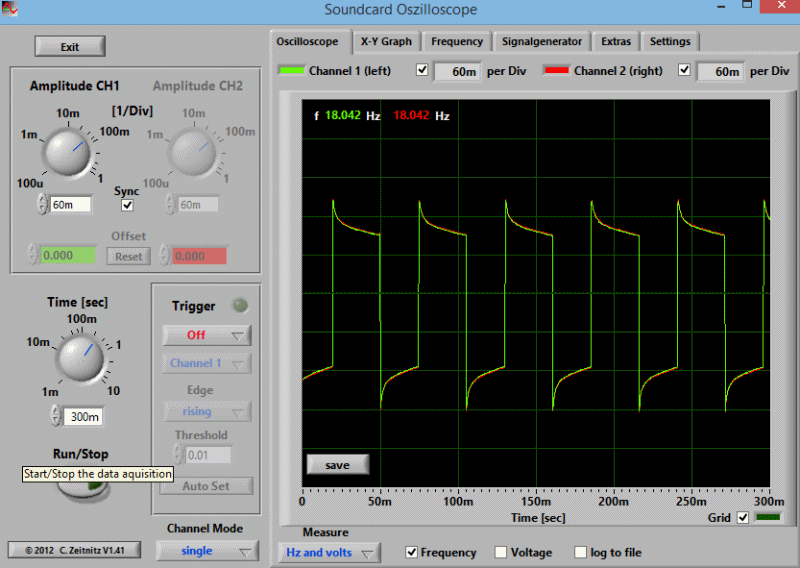
The fast strobe mode is a disorienting ~18Hz tactical strobe. :green:
Slow Strobe:
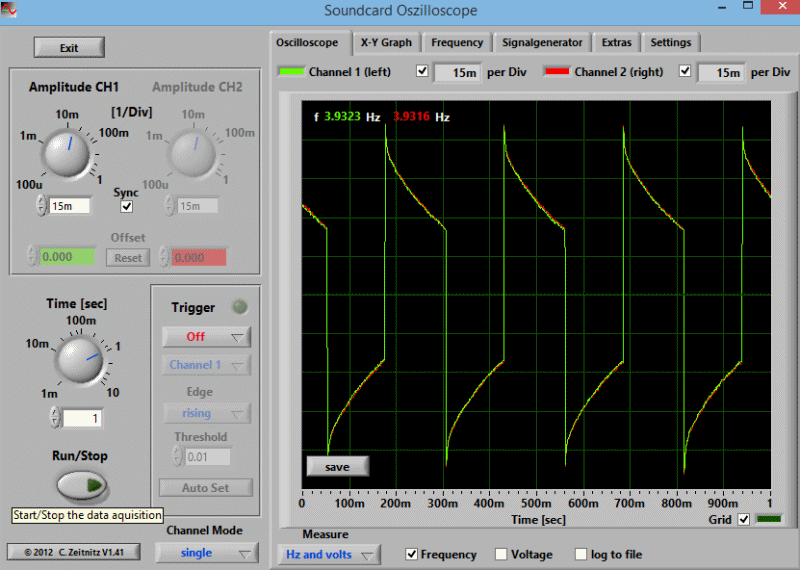
The slow strobe has a frequency of ~4 Hz, which makes it a good general signaling strobe.
Hi Beacon:
Lo Beacon:
The beacon modes have a common frequency of one quick flash, exactly every 5 secs. The intensity is different between the two modes (i.e., one at max, one at a lower level)
The blinking modes are basically unchanged from the SC600-II
Standby Drain
Due to the electronic switch, all Zebralights have a constant parasitic stand-by current drain when the tailcap is connected.
My SC62 has a negligible 4.3uA on 18650 (exactly the same as my SC600-II). This is well below the self-discharge rate of a standard battery, and not at all a concern (i.e., for a 3100mAh cell, that would theoretically translate into over 82 years before the battery would be drained).
As before, you can fully break this current - and physically lock-out the light - by twisting the tailcap a quarter turn.
Beamshots:
For white-wall beamshots below, all lights are on Max output on an AW protected 18650 battery. Lights are about ~0.75 meter from a white wall (with the camera ~1.25 meters back from the wall). Automatic white balance on the camera, to minimize tint differences.
Let's start with a comparison to other popular compact 1x18650 lights:
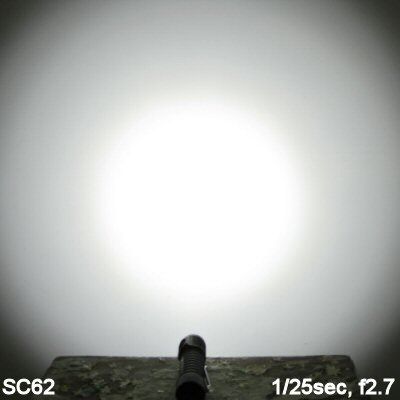
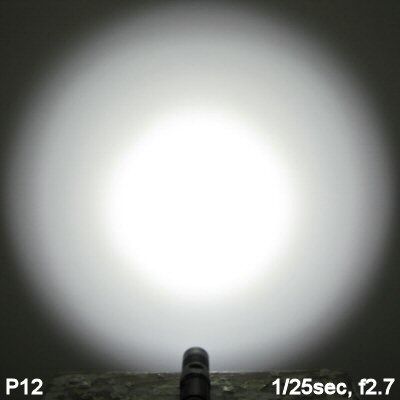
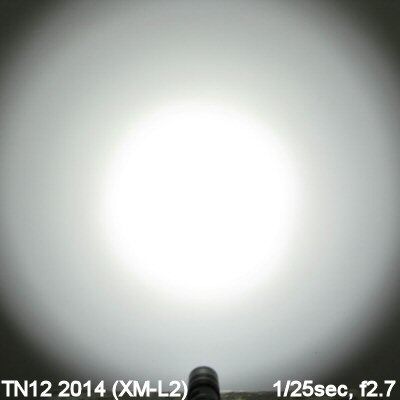
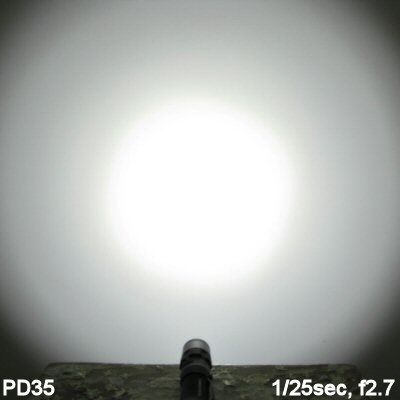
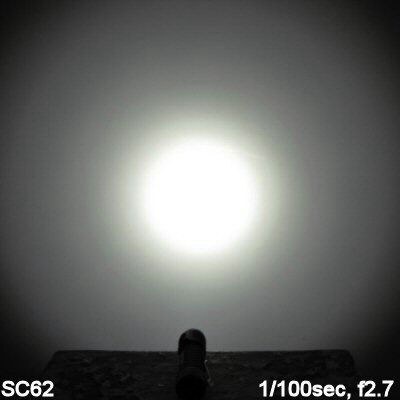
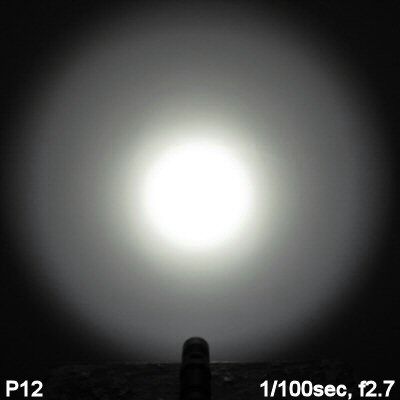
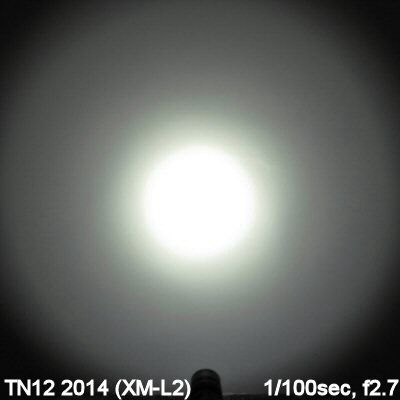
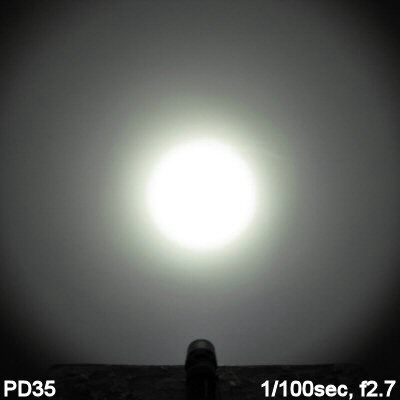
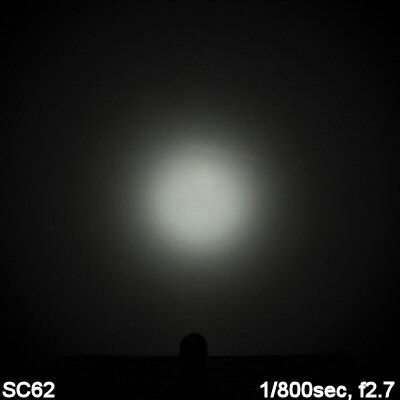
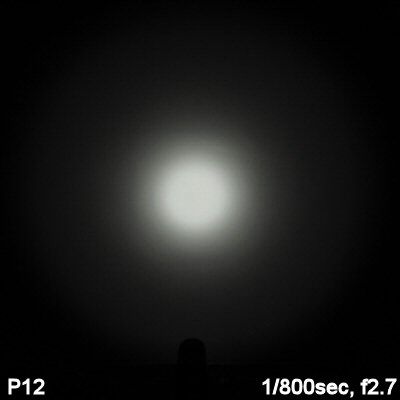
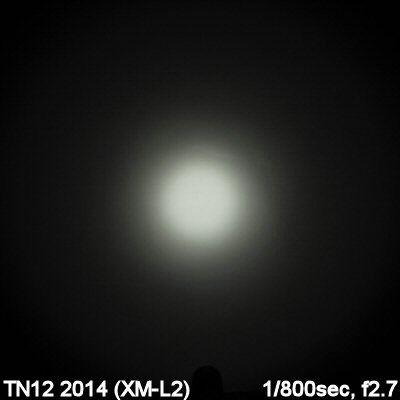
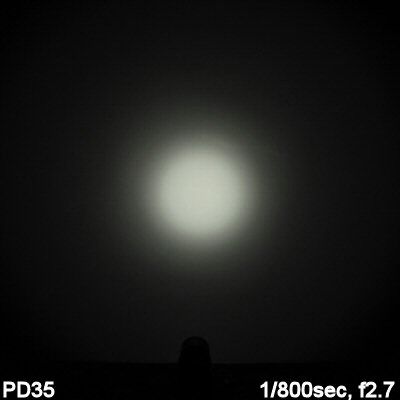
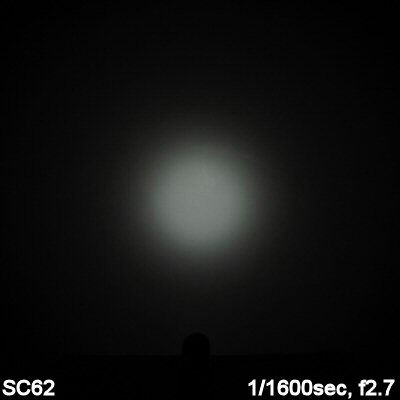
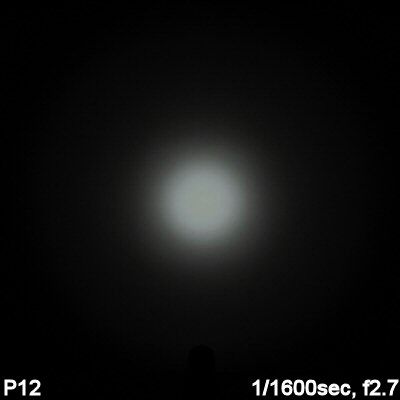
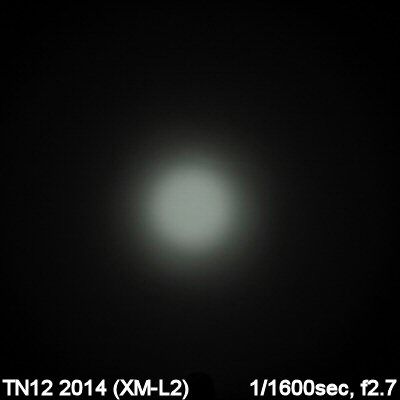
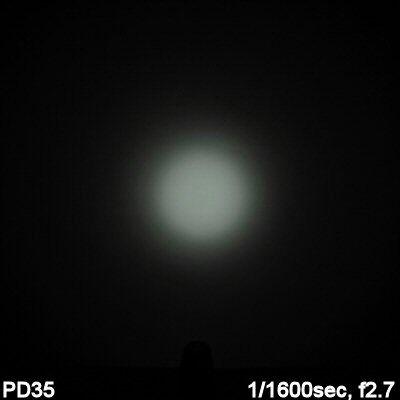
The SC62 has the beam profile you would expect, given the overall size. In fact, it's probably helpful to compare to the SC600-II and SC52 from Zebralight (as it is has basically the same circuit as the SC600-II, but in a body with the same size head as the SC52).

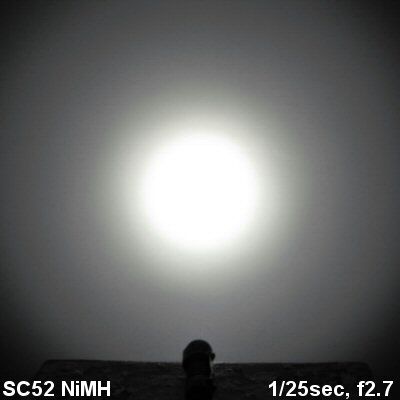
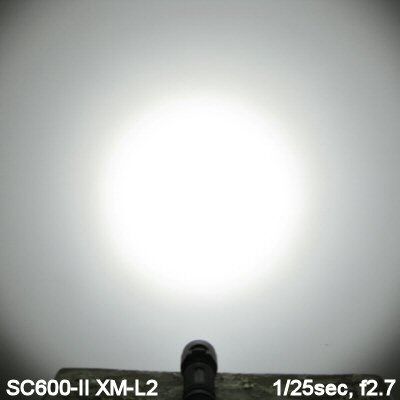

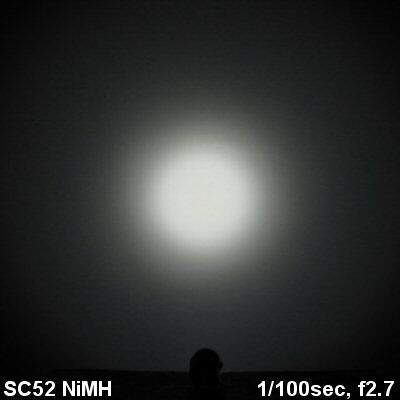
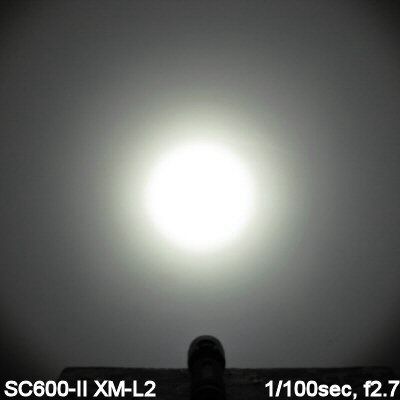

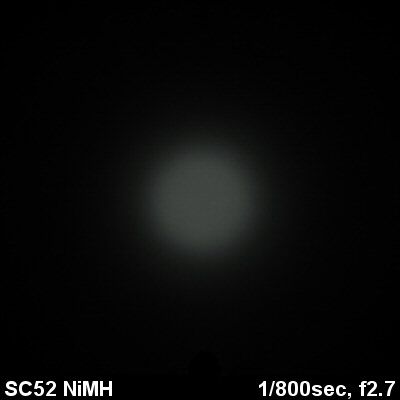
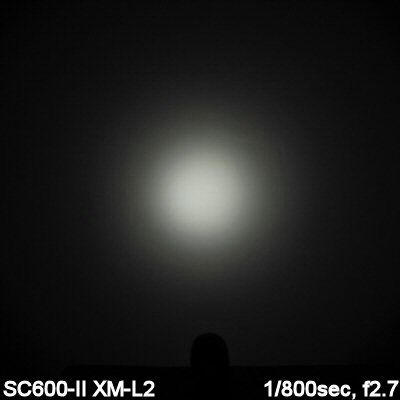

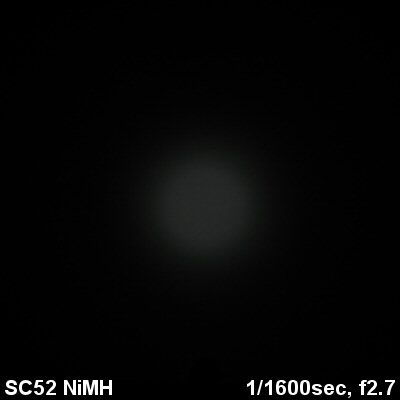
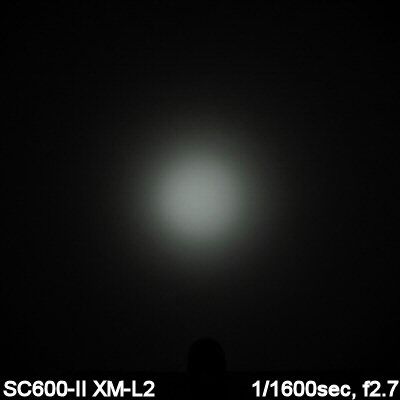
Take-home message is that the SC62 is not as throwy as the SC600-II. And if matched for output, would look the same as the SC52.
Testing Method:
All my output numbers are relative for my home-made light box setup, as described on my flashlightreviews.ca website. You can directly compare all my relative output values from different reviews - i.e. an output value of "10" in one graph is the same as "10" in another. All runtimes are done under a cooling fan, except for any extended run Lo/Min modes (i.e. >12 hours) which are done without cooling.
I have devised a method for converting my lightbox relative output values (ROV) to estimated Lumens. See my How to convert Selfbuilt's Lightbox values to Lumens thread for more info.
Throw/Output Summary Chart:
My summary tables are reported in a manner consistent with the ANSI FL-1 standard for flashlight testing. Please see http://www.flashlightreviews.ca/FL1.htm for a discussion, and a description of all the terms used in these tables. Effective July 2012, I have updated all my Peak Intensity/Beam Distance measures with a NIST-certified Extech EA31 lightmeter (orange highlights).
Note that I have updated the lumen estimates for a few of the highly-driven lights, based on 3100mAh 18650 testing.
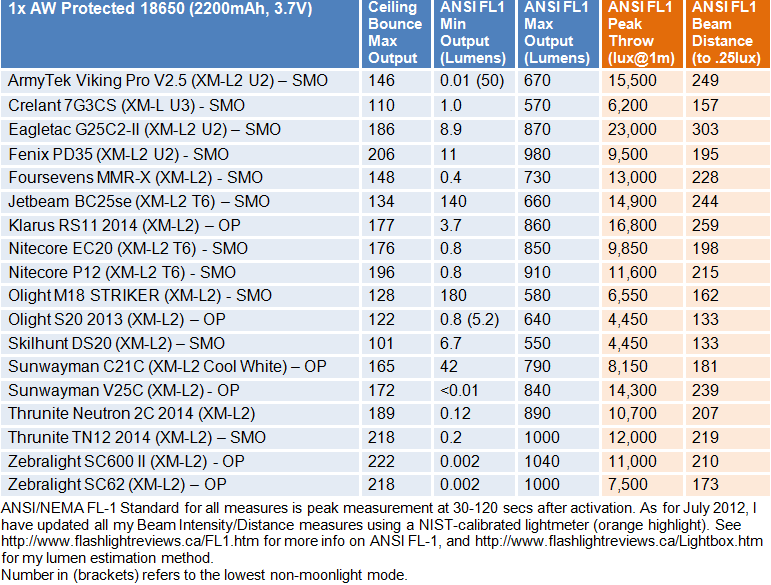
As you can see above, the SC62 has virtually the same dynamic range as the SC600-II. The initial difference in max output is subtle – you can only detect it with a lightmeter/lightbox. See my runtimes for more information as to what happens over time, however.
Throw is of course reduced at all levels, due to the smaller head.
Let's see how all the initial output levels compare to the SC600-II, on my estimated lumen scale:
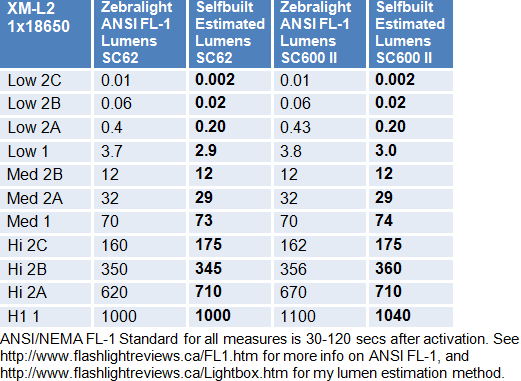
My SC62 and SC600-II have some very minor variation between a few of the levels. I would consider them generally equivalent for output.
As you will see above, my lumen estimates are pretty close to Zebralights specs (at least for non-moonlight modes). But as always, note that my lumen estimation method is just an estimate based on the calibration of my lightbox. As such, don't get caught up on the absolute difference between lights or levels, as I can't guarantee absolute accuracy. Focus instead on the relative differences, as that is internally consistent across all my reviews.
Output/Runtime Graphs:
I previously used AW protected 2200mAh batteries in all my runtime tests, due to their ability to fit and work in every light – and their consistent capacity levels across samples and batches over time. I have been testing a variety of brands of protected NCR18650A (3100mAh capacity) batteries, to see if I can provide compilations that fit in different lights – but show similar performance characteristics. I have found a range of brands that show good correlations and internal consistency, so will now start showing 3100mAh runtimes in my reviews. :wave:
Note that all my standard runtimes are done under a cooling fan, as always. This is an important reminder, given the use of a common PID (Proportional-Integral-Differential) thermal regulation algorithm on the SC62 and SC600-II. You can read up more about PID controllers online, but basically they are a more sophisticated mechanism to regulate circuit function in regards to temperature than the typical step-down features we are used to with flashlights. The controller has to be specifically customized to the build in question, and can be thought of a refinement/replacement of the typical current-control regulation we are more commonly used to.
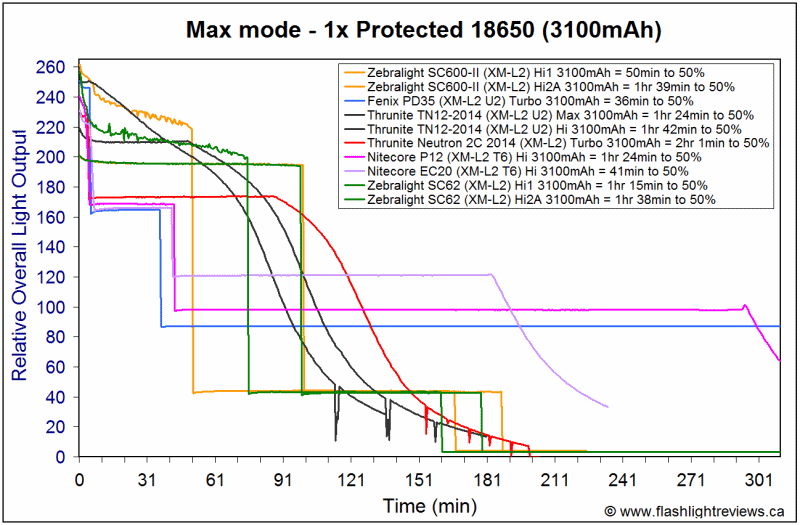
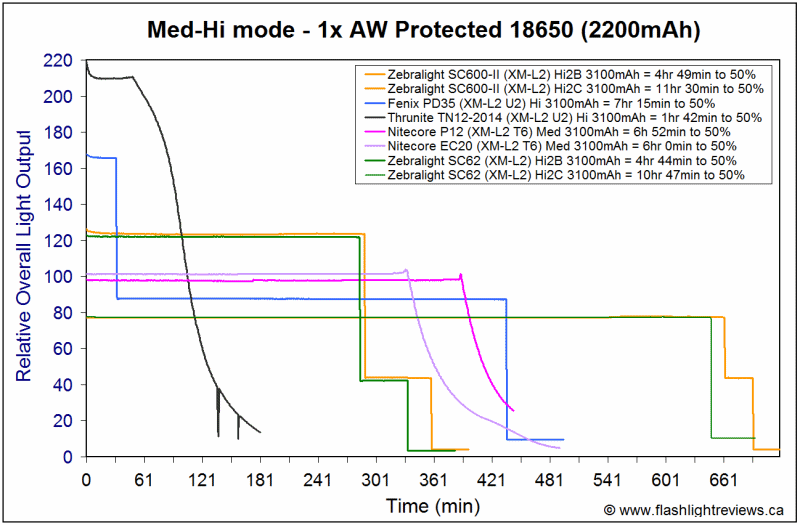
The first observation on Max (Hi1) is that the PID thermal regulation drops the output faster on the SC62 than it does on the SC600-II. Zebralight confirms that two lights are using the same PID algorithm, so the difference must be due to the lower mass of the SC62 head (and thus, its reduced heatsinking ability). Again, you are looking at runtimes done under a cooling fan above – scroll down for a more real-world comparison without cooling.
A second observation is that the SC600-II and SC62 are indeed equivalent for output/runtime performance across levels. There really is nothing to distinguish the curves for the Hi2A level on down.
As before, Zebralight's SC62/SC600-II show excellent overall efficiency and regulation on 18650. :thumbsup:
Let's see how the SC62 performs on max, with and without cooling:
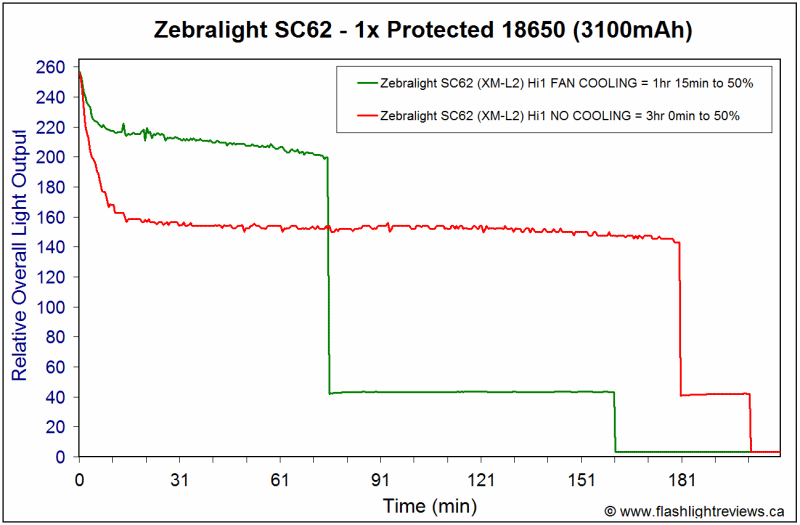
Without externally supplied cooling, the PID thermal regulation circuitry will lower output to a greater extent. As with the SC600-II (which uses the same algorithm), there are a lot of very finely discriminated steps in output change occurring (i.e., the "messy" aspect of the curves above). These will not be apparent to you in practice, as they are too subtle to see (i.e., only the lightbox can detect them).
My non-cooled SC600-II showed a less dramatic (and rapid) reduction in output, compare to the non-cooled SC62 runtime above. Again, I suspect this is due to the lower thermal mass for heatsinking available on the SC62. :shrug:
Note as well that both the Hi1 and H2A levels use PID, so you can expect some potential reduction on both levels. Of course, any reduction in output will increase the runtime (as you can see above for the Hi1 mode).
UPDATE: As requested, here is a comparison of hand-holding vs fan cooling on the PID-controlled output:
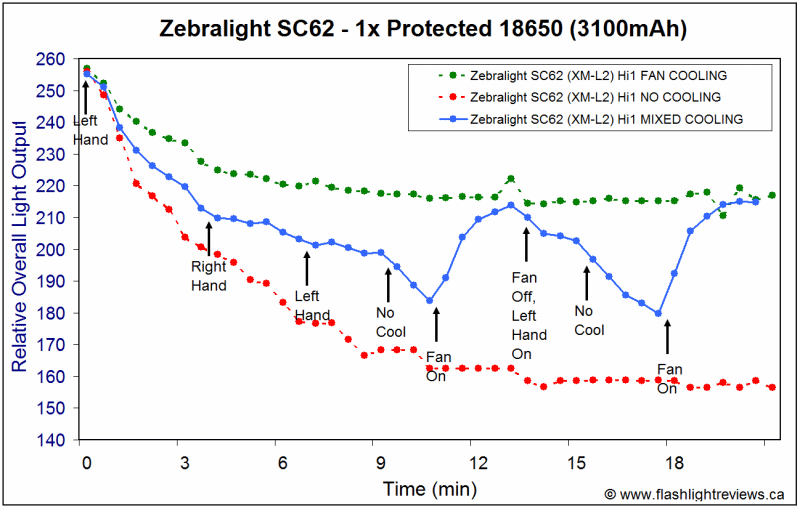
I held the light on max with thumb just below switch, index finger behind the head, and hand wrapped around body. I found the SC62 too hot to hold for more than ~3-4 mins without switching hands (i.e., thumb and index finger get too hot). After doing this several times, I let the light sit with no cooling for a few mins, followed by several mins of fan cooling. I then again held it for a few mins, let go with no cooling, and finally turned the fan back on.
As you can see above, hand-holding results in clearly intermediate output compared to fan cooling or no cooling. As an aside, I am quite impressed by the rapid responsiveness of the PID thermal regulation system. It responds almost instantly to any change in the surroundings.
In case you are wondering how different 18650 batteries compare at the highest level, here is a comparison:
]
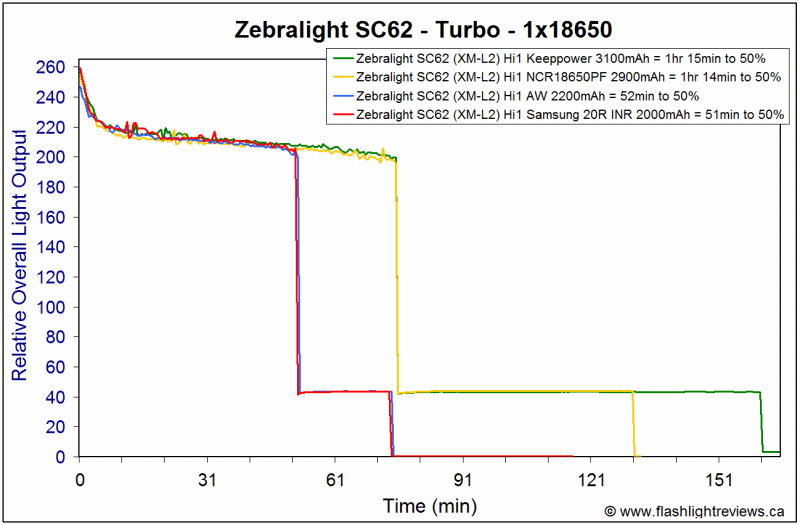
It's hard to see, but the AW protected 2200mAh batteries do show a slight reduction in initial output, compared to the other batteries. But the PID thermal control tends to regulate all batteries to similar output levels very quickly.
As you can tell from above, the higher current rated cells (i.e., Samsung 20R and Panasonic NCR18650PF) tend to use up most of their stored energy before step-down occurs.
Potential Issues
Like its SC600-II predecessor, the SC62 is 1x18650 only (i.e., it doesn't take 2xCR123A or 2xRCR).
As with other heavily-driven lights, some 18650s may not be able to handle the sustained discharge rate on Max. I recommend you stick with high-quality cells.
Some thicker or longer high-capacity cells may be a tight fit in the SC62, just as they were in the SC600-II (i.e., internal body diameter of the lights is the same)
Switch timing takes a little getting used, if you aren't already familiar with Zebralight.
Preliminary Observations
Performance-wise, the SC62 is basically the SC600-II carried over into a smaller body. The same is true of the H600/H602 headlamp, which should have identical performance to the SC62 tested here. :wave:
This results in some obvious differences – due to the smaller head, the SC62 won't throw as far as the SC600-II. Similarly, due to the reduced mass for heatsinking, you can expect the PID thermal regulation feature to drop output more quickly on the H1 and H2A modes of the SC62/H600/H602 (compared to the original SC600-II, which uses the same PID algorithm). Zebralight informs me that initial max output is also a tiny bit lower on the SC62/H600/H602, due to one component that had to be reduced to fit inside the smaller head. My results confirm this minute difference on initial HiA output.
As before, I like the sophistication of the PID thermal control. As you can see in my detailed testing above (and in my SC600-II review), this is an efficient way to maintain a good balance between output and runtime. In the case of a heavily-driven but small-body light like SC62, this is a reassuring feature. :bow:
Output/runtime efficiency remains top-of-class for the SC62, just like the SC600-II (which has equivalent output levels). :thumbsup: As always, I quite like the low battery voltage step-down feature (on all levels), as it means you will never get stuck with no light without warning. Regulation patterns are excellent, in my view. Keep in mind however than only 1x18650 is supported, as before.
The switch feel and user interface is basically unchanged from the SC600-II – and will seem very familiar to Zebralight owners.
Due to the smaller head, the beam pattern of the SC62 is basically identical to the SC52 (except with more output, of course). The SC600-II was never a great thrower, so this may be a trade-off many are willing to make for the considerably smaller size.
In that sense, I think the SC62 fits into quite a "sweet spot" - you get a very small form factor light (i.e., not much bigger than some 1xAA lights), with outstanding output, range of levels, and excellent storage capacity (thanks to newer 18650 batteries). And the PID thermal regulation ensures you don't have to worry about over-heating (or artificially set step-down timings). The SC62 and its H600/H602 headlamp equivalents are definitely a strong contenders in the 1x18650 space. Hopefully you will find the detailed comparisons above useful in comparing lights. :wave:
----
SC62 provided by Zebralight for review.
Last edited:


